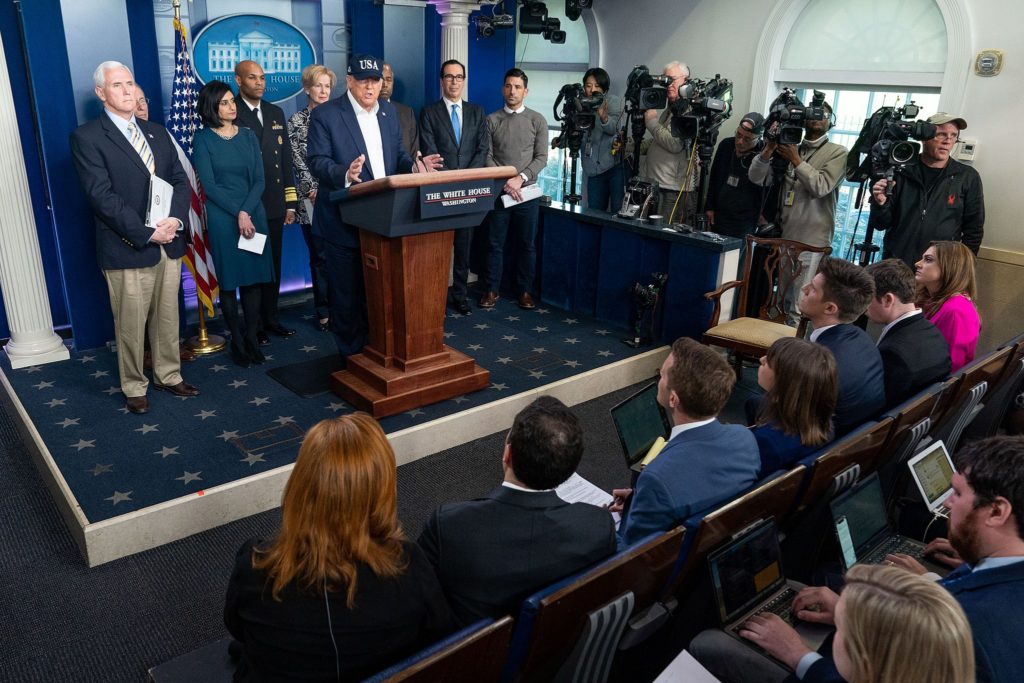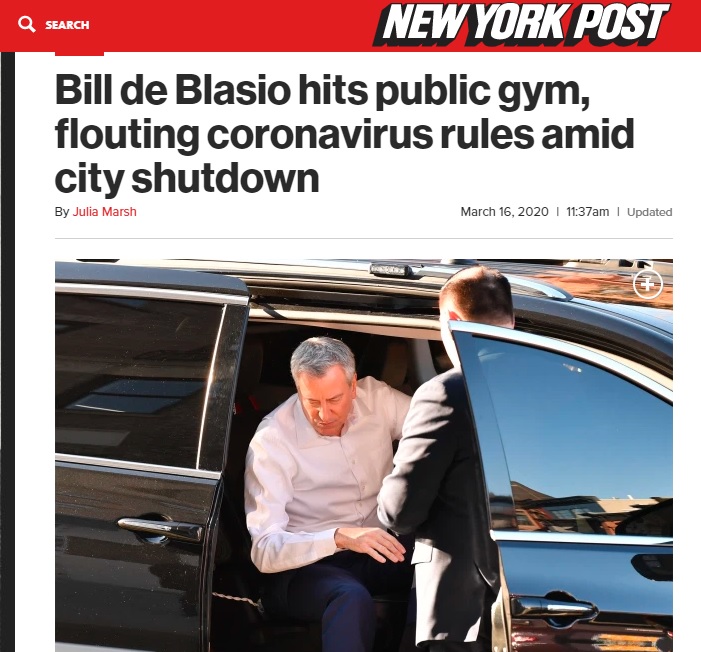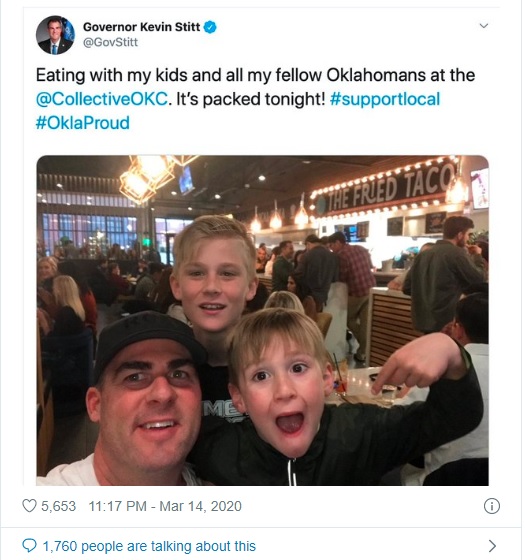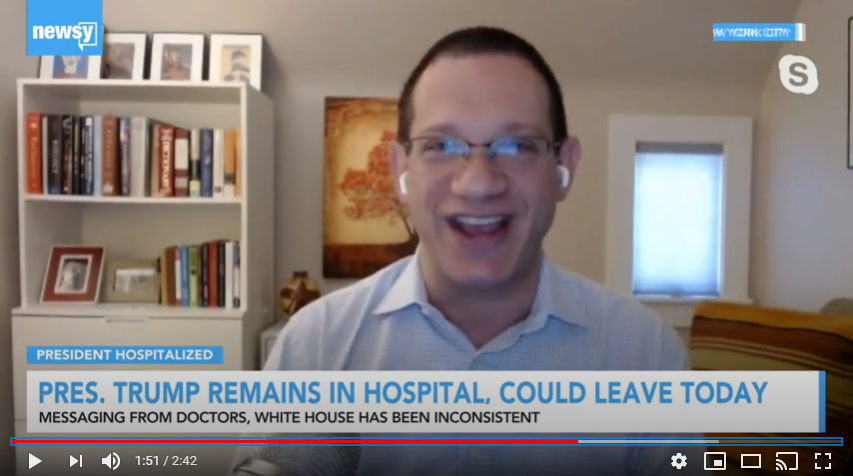Coronavirus and Politics: When Message Disconnects Magnify Risks

President Trump, joined by Vice President Pence and members of the White House Coronavirus Task Force, takes questions from the press at a coronavirus update briefing Saturday, March 14, 2020, in the James S. Brady Press Briefing Room of the White House. Photo by D. Myles Cullen, White House
It may be how he stays “grounded,” but when New York City Mayor Bill de Blasio snuck in one last trip to the YMCA in Brooklyn yesterday morning, it brought on the critics.
Admittedly, few of us – political leaders included – have been up against the radical changes to everyday life that the spread of the coronavirus has forced us to make. But his visit remains one of several recent examples of politicians employing a “Do as I say, not as I do” approach when it comes to coronavirus messaging.

Screenshot from the New York Post.
De Blasio’s decision to take the 12-mile drive from Gracie Mansion to the gym, while using his NYPD security detail to ferry him there, was a tone-deaf response to the messages that he was giving his constituents, let alone those given by federal, state, and other city leaders. In effect, they said, we were all going to have to make some fundamental changes and practice some self-sacrifice to our daily routines to avoid the spread of the coronavirus.
One of De Blasio’s former advisers, Rebecca Katz, was among the critics. Here’s what she had to say:
History will not look kindly on this move. https://t.co/ScFVyBn7aC
— Rebecca Katz (@RebeccaKKatz) March 16, 2020
No current or former staff member should be asked to defend this.
The Mayor’s actions today are inexcusable and reckless. https://t.co/tjz3AQHpzu
— Rebecca Katz (@RebeccaKKatz) March 16, 2020
De Blasio’s act seemed inconsistent with what another public leader had advocated over the weekend. Dr. Anthony Fauci, the director of the National Institute of Allergy and Infectious Diseases, said on several televised news programs that he wanted to see a dramatic drop in personal interaction in places such as restaurants and bars. He didn’t mention gyms, but those watching got a good idea of what he was talking about.
During the past several days, there have been other examples of inconsistencies:
1. After numerous public health officials advised social distancing and limited physical contact, President Trump repeatedly shook hands with multiple guests at a press conference on March 13. The speakers were also in close proximity to one another – far closer than the six feet that had been advised.
2. In Oklahoma, Gov. Kevin Stitt got into hot water for posting a defiant photo of himself and his children at a crowded restaurant last weekend (he later deleted the tweet).

Screenshot from KFOR-TV
3. Then, Oklahoma City Mayor David Holt was similarly chastised on Sunday for tweeting an image of a dish from a local restaurant, along with his encouragement to his followers to “eat local.”
Eat local. #1OKC pic.twitter.com/g2rUrvyHy2
— Mayor David Holt (@davidfholt) March 15, 2020
Talk about a message disconnect: later that same day, he declared a state of emergency because of community spread of the disease. This is what he said:
“Limiting close personal contact is our only real tool of mitigation, and on the advice of public health officials, and with the confirmation of local spread, we feel it is now time to do more. I do not proclaim this state of emergency casually, and I am fully aware of the gravity of the moment. But this is a time to protect the people of Oklahoma City.”
4. Over the weekend, Dr. Fauci said he wouldn’t eat at crowded restaurants. He also said he wouldn’t fly on planes unless absolutely necessary. The Centers for Disease Control advised older adults and travelers with underlying health issues to avoid crowded places, long plane rides, and cruises. But that didn’t stop Rep. Devin Nunes (R-CA) from saying Americans should go out with their families to their local restaurant or pub – comments he later tried to walk back.
5. Finally, making the rounds on social media were images of crowded public places and calls on officials in those places to get with the program, so to speak.
#SocialDistancing in Clearwater Beach, FL #SocialDistancingNow #SocialDistancingWorks #socialdistancefail #SocialDistancingFail #CoronavirusOutbreak #COVID19 #CoronavirusUSA #CoronaVirusUpdates #coronavirus #CoronavirusPandemic #CoronaVirusChallenge #Coronavirusflorida pic.twitter.com/IMAHU0lc8Z
— MedTalk (@iMedTalk) March 16, 2020
The Right Message
It is easy to point fingers in this time of fear and uncertainty. As you see images of young people packed in bars or crowds on public beaches, it’s easy to criticize them on social media and condemn them for irresponsible behavior.
Yes, some of it may be magical thinking. If they act normal, things will go back to being normal. But, it’s important to point out that when messaging is inconsistent across federal, state, and local channels, and public officials seemingly flout their own advice, it can lead to confusion, which may be driving this irresponsible behavior.
That’s why it is so important for those crafting messages to the public to realize words and actions matter. Moving forward, political and other public leaders will be the people businesses, institutions, and citizens will be listening to, and watching, to gauge the actions they should be taking in light of this extraordinary global pandemic.
This goes, too, for anyone who runs a business, leads a school system, or heads a nonprofit institution.
Here are some tips on what effective coronavirus messaging needs to be:
Clear and consistent – This is a fast-moving crisis, but little does more to create confusion than vague and inconsistent messaging. Be clear about what you know. And, make sure any actions you urge to your audiences are consistent with public health advisories.
Fact-based – Base your decisions and action plans in the most readily available facts and best practices touted by scientific agencies.
Direct – People are looking for answers. Where possible, offer direct information about the next steps your audience needs to take.
Honest – There’s a fine line between stoking unnecessary fear and providing answers. However, frank messages, based on the best-available information, can help to dispel rumors that may lead to poor decisions.
Empathetic – Express that what you are asking is difficult, but that you will be doing it yourself. Then, do it.


